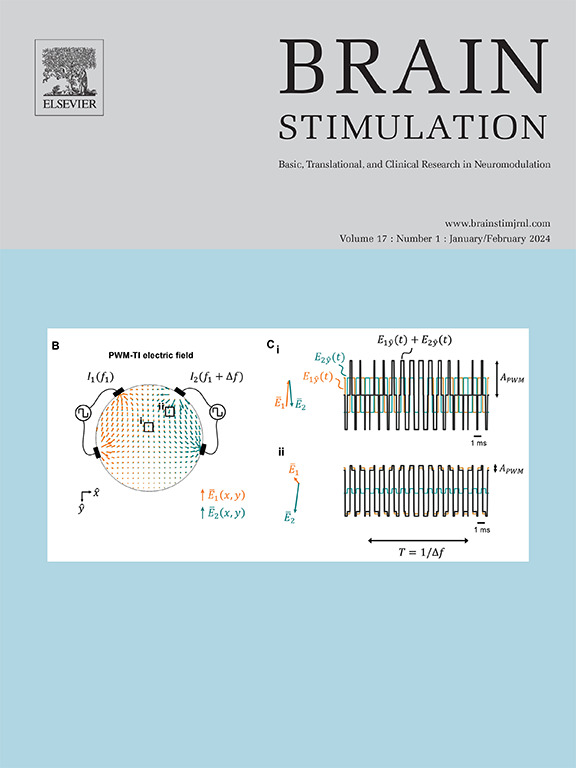Divergent responses of glutamatergic and GABAergic prefrontal neurons underlie changes in excitability following low and high frequency repetitive brain stimulation
IF 8.4
1区 医学
Q1 CLINICAL NEUROLOGY
引用次数: 0
Abstract
Background
Repetitive brain stimulation is hypothesized to bidirectionally modulate excitability, with low-frequency trains decreasing and high-frequency (>5 Hz) trains increasing excitability in the brain. However, most insights on the neuroplastic effects of repetitive stimulation protocols stem from non-invasive human studies (TMS/EEG) or from rodent slice physiology. Here, we developed a rodent experimental preparation enabling imaging of cellular activity during repetitive stimulation protocols in vivo to understand the mechanisms by which brain stimulation modulates excitability of prefrontal cortical neurons.
Methods
Repetitive trains of intracortical stimulation were applied to the medial prefrontal cortex using current parameters (100 μA, 400 μs pulses) guided by prior rodent studies of intracortical microstimulation. Calcium imaging of glutamatergic (CamKII) and GABAergic (mDLX) neurons was performed before, during, and after stimulation in awake rodents (n = 9 females). Protocols included low-frequency (1 Hz, 1100 pulses) and high-frequency (10 Hz, 3000 pulses), with sham stimulation as a control.
Results
Glutamatergic neurons were differentially modulated by stimulation frequency, with 10 Hz increasing and 1 Hz decreasing activity during stimulation. Post-stimulation, 1 Hz stimulation resulted in a long-term inhibition of glutamatergic and increased activity of GABAergic neurons, resulting in a net decrease in the excitation/inhibition ratio. 10 Hz selectively suppressed GABAergic neurons with no long-term change in glutamatergic neuronal activity, resulting in a net increase in the excitation/inhibition ratio.
Conclusions
These findings provide direct evidence that repetitive brain stimulation protocols used clinically can induce long-term modulation of prefrontal cortical excitability, with low-frequency stimulation inhibiting glutamatergic neurons and high-frequency stimulation inhibiting GABAergic neurons.
谷氨酸能和gaba能前额叶神经元的不同反应是低频和高频重复脑刺激后兴奋性变化的基础。
背景:重复脑刺激被假设为双向调节兴奋性,低频序列降低,高频(bbb5 Hz)序列增加大脑的兴奋性。然而,大多数关于重复刺激方案的神经可塑性效应的见解来自非侵入性人体研究(TMS/EEG)或啮齿动物切片生理学数据。在这里,我们开发了一种啮齿类动物实验准备,能够在体内重复刺激方案中成像细胞活动,以了解脑刺激调节前额皮质神经元兴奋性的机制。方法:在啮齿类动物皮层微刺激实验的指导下,利用电流参数(100 μA, 400 μs脉冲)对内侧前额叶皮层施加重复的皮层内刺激序列。在刺激前、刺激中、刺激后分别对醒鼠(雌性9只)谷氨酸能(CamKII)和gaba能(mDLX)神经元进行钙显像。方案包括低频(1hz, 1100次脉冲)和高频(10hz, 3000次脉冲),并以假刺激作为对照。结果:刺激频率对谷氨酸能神经元的活性有差异调节,刺激频率为10 Hz时神经元活性增加,1 Hz时神经元活性降低。刺激后,1 Hz刺激导致谷氨酸能的长期抑制和gaba能神经元的活性增加,导致兴奋/抑制比的净降低。10hz选择性抑制gaba能神经元,谷氨酸能神经元活性无长期变化,导致兴奋/抑制比净增加。结论:这些发现提供了直接证据,证明临床使用的重复性脑刺激方案可以诱导前额叶皮层兴奋性的长期调节,低频刺激抑制谷氨酸能神经元,高频刺激抑制gaba能神经元。
本文章由计算机程序翻译,如有差异,请以英文原文为准。
求助全文
约1分钟内获得全文
求助全文
来源期刊

Brain Stimulation
医学-临床神经学
CiteScore
13.10
自引率
9.10%
发文量
256
审稿时长
72 days
期刊介绍:
Brain Stimulation publishes on the entire field of brain stimulation, including noninvasive and invasive techniques and technologies that alter brain function through the use of electrical, magnetic, radiowave, or focally targeted pharmacologic stimulation.
Brain Stimulation aims to be the premier journal for publication of original research in the field of neuromodulation. The journal includes: a) Original articles; b) Short Communications; c) Invited and original reviews; d) Technology and methodological perspectives (reviews of new devices, description of new methods, etc.); and e) Letters to the Editor. Special issues of the journal will be considered based on scientific merit.
 求助内容:
求助内容: 应助结果提醒方式:
应助结果提醒方式:


